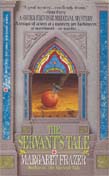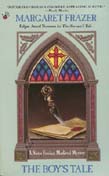THE HISTORY IN THE MYSTERY #1 THE COLD AND THE DAMP: WHITHER THE WEATHER  
At
a question-and-answer session someone once asked me why I have so much
weather in my books. The question took me aback for a moment, since it
had never occurred to me not to
have weather in my books. For one thing, I like weather, which is just
as well because I live in a part of the world where there are four
radical seasons, and within each season conditions can vary widely from
day to day, so Iíd be in trouble if I didnít like weather. Thereís so
much of it here. As for using it in my stories, for me weather is part
of each dayís texture, and because I like stories that have texture, I
weave weather deeply into mine, hoping to give them richer texture and
the deeper-set sense of time and place that comes with that. Mind you, sometimes I succeed all too well. When my then-co-author and I were reading the galley proofs of The Servantís Tale
(set in a very bleak midwinter) we found ourselves breaking off to have
one sort of hot drink or another, not something we commonly did when
working. Only later did we realize the cold and damp we were reading
about in the story were actually making us feel the need for something
warm to compensate. That was very disconcerting, more especially since,
in one sense, the weather was not even our fault: That was what the
weather actually was like during that particular winter in England. In
fact, there were several wet, cold years of bad harvests and hard
winters in succession during the 1430s, and for several books the
weather is simply miserable. Not because I wanted it to be, but because
that was what it was. How can I know something like that? In my
research over the decades, I have accumulated all manner of information
(some day Iíll tell you about my Chronology Cards) from all manner of
sources, including medieval chronicles. And one of the things included
in chronicles are reports of unusual weather. When no report is made
about the weather in any chronicle, I have assumed that the weather was
within its ordinary parameters and have felt free to have days of
ordinary sunshine and simple rain or snow or whatever. But sometimes
very specific reports are made in the chronicles -- such as the three
years of famine brought on by wet, cold summers in the early 1430s,
culminating in a winter of excessive cold when the Thames froze at
London. So in the three books set during that time, the weather is
miserable -- and itís not my fault. On the other hand, when it came time to pick a time of year to set The Boyís Tale as the next book in the series, the choice of a warm and sunny June was not random in the least. In fact, it was something of a holiday. - Margaret |